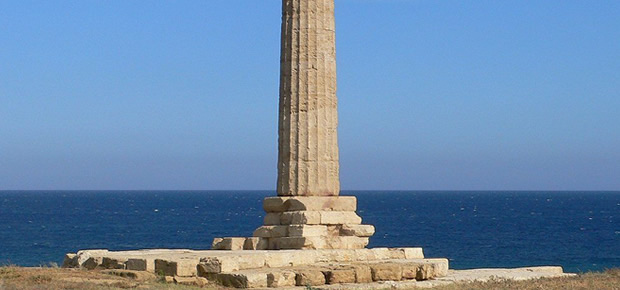
3.4 Crotone
The rival of Sybaris, Crotone, was also colonized by Achaeans, about the same time. The Achaean origin of Crotone was universally ac-cepted in antiquity. The Croton shook with their two neighboring towns, Caulonia and Sybaris on Traente, a covenant on the model of the Achaean League. Of the founding of Croton we have many news from reliable historical sources that have handed down even the name of his ecista, Miscello. From a fragment of Diodorus we know that the Pythia would initially ordered Miscello to found Croton; then with a second response would have illuminated the location of the new city, advising him to move from the head Lacinio, the sacred and the River Crimisa Esaro; finally, with a third response forbade him to go to Sybaris against the will of god.
Sull'ecista of Croton have been handed down two more news. A, reported by the scholiast of Aristophanes, is the simple repetition of a story on the foundation of Taranto at the hands of Falanto. The other, tramandataci to Ovidio, Heracles does intervene in the founding of Croton: according to the author of Metamorphosis, Miscello he would go on to found Croton shore all'Esaro to obey an explicit order of Heracles, although the laws of his country forbade emigration so far, pena the dead. And already in the sixth century it was thought that the colony had been founded by order of the oracle of Delphi: as demonstrated by the Delphic tripod which is engraved on the right and on the verso of the first coins minted from Crotone and that remained the emblem of the city until the Roman. Also in this case, how to Reggio, Syracuse per the per Taranto, the oracle of Apollo served as a guide to the new settlers. But it is clear that the Pythia was able to provide detailed guidance on the new countries in the West only after receiving information from Eubei who had frequented those seas from the first half of the eighth century.
According Ippide and second Antiochus, Croton was founded shortly after Sybaris, rather, a very short time after, so much so that Eusebius places the foundation of Sybaris and Croton in the same year. The date given by Eusebius, is confirmed by Dionysius of Halicarnassus, who says that Croton was founded in the third year of the XVII Olympiad, namely in 709-708 a.C. The main place of worship was chosen a little 'more to the south, the Head Lacinio, now called Capo Colonna. At this location the Greek city of Croton was the most famous temples, the temple of Hera Lacinia. The temple of the sixth century that today is not a solitary column. Livy tells us that the walls of Crotone, at the beginning of the third century, well measured eighteen kilometers. But do not remain today traces of the ancient city, with the exception of a few fragments of wall scattered here and there. Croton was celebrated by the ancients so much for the force and beauty of its inhabitants as well as for the health of its climate. Even today, the small town where he was the kind modern ancient city, enjoys a mild climate, for the sea breezes that protect against malaria present in the lowlands of the crater. Instead, the campaign of Crotone, pur assai fertile, could not compete for extension and wealth of products with that of Sybaris.




